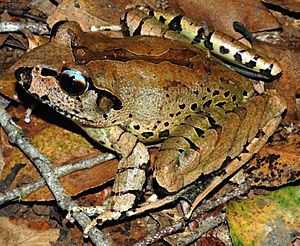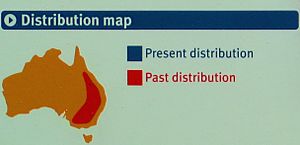David Fleay facts for kids
Quick facts for kids
David Howells Fleay
AM MBE
|
|
|---|---|

David Fleay and a brown snake, 1954
|
|
| Born | 6 January 1907 |
| Died | 7 August 1993 (aged 86) |
| Education | Ballarat Grammar School |
| Occupation | Biologist |
| Known for | Captive breeding of endangered species |
David Howells Fleay (6 January 1907 – 7 August 1993) was an amazing Australian scientist and biologist. He was a pioneer in helping endangered species have babies while in captivity. He was also the first person ever to successfully breed a platypus in a zoo!
David Fleay passed away on August 7, 1993, when he was 86 years old.
Contents
Early Life and Education
David Fleay was born in Ballarat, Victoria. His family had a strong interest in nature and art. His mother, Maude Edith Victoria Fleay, was a talented wildlife artist. His father, William Henry Fleay, was a chemist.
David went to a state primary school and then Ballarat Grammar School. After school, he worked in his father's chemist shop. For a short time, he was also a teacher at Ballarat Grammar.
In 1927, David moved to Melbourne to study at Melbourne University. He studied science, focusing on zoology (the study of animals) and botany (the study of plants). He also studied education. In 1931, he graduated and married a fellow student, Mary Sigrid Collie. He then worked as a teacher in Ballarat until 1934.
Working with Wildlife
David Fleay became interested in the natural world at a time when people were starting to care more about endangered animals. They realized that Australian animals were special and needed protection.
Saving Endangered Animals
David understood how important it was to protect rare animals very early on. In 1933, he was the last person to photograph a thylacine (also known as the Tasmanian tiger) that was living in a zoo. During this time, he was bitten by the thylacine and carried the scar proudly for the rest of his life.
In 1934, David was asked to help design and set up the Australian animal section at Melbourne Zoo. He worked there for four years. During this time, he achieved many scientific firsts. He was the first to breed emus, several bird species like the tawny frogmouth, and marsupials like the koala in captivity. He also started researching how to breed platypuses.
David also shared his knowledge with the public. In 1937, he gave nature talks on a Melbourne radio station. Later that year, he left the zoo because he disagreed with how they were feeding the animals. He believed native animals should eat what they would find in the wild.
In 1962, David Fleay helped start the Wildlife Preservation Society of Queensland. This group worked to protect wildlife in Queensland.
Healesville Sanctuary Achievements
After leaving Melbourne Zoo, David was asked to become the director of the Healesville Sanctuary. This sanctuary was about 90 km from Melbourne. It had animals like quolls, Tasmanian devils, dingoes, and various birds. David added tiger snakes, which were milked for their antivenene (medicine for snake bites), and platypuses.
Many animals at Healesville lived in large, open areas. Visitors could even interact with some of them. David also did daily shows where he fed the platypuses.
His biggest success at Healesville happened in 1943. He became the first person to breed a platypus in captivity! He designed a special platypus enclosure that copied their natural home. Around November 5, 1943, a baby platypus named "Corrie" was born. No one else managed to breed and raise a platypus until 1998, when Healesville Sanctuary did it again. Since then, it has only happened two more times.
Between 1945 and 1947, David went on a trip to Tasmania. He hoped to catch a male and female thylacine to breed them, but he didn't find any.
In 1947, he took three platypuses to the Bronx Zoo in New York. He helped them build a special home for the platypuses. He also visited other zoos in the US to learn more about animal care. When he returned to Healesville, he found out he had been dismissed. The zoo board thought he had given animals away without permission, which was not true. This made him very sad, and he was demoted to a consultant role.
David also had his own private collection of animals. But in 1951, the government in Victoria made a law that stopped private people from charging money for others to see their animal collections. This made him decide to move his collection.
David Fleay Wildlife Park in Queensland
After a lot of searching, David chose a new location in Queensland. It was near Burleigh Heads on the Gold Coast. This area was perfect because it had natural habitats for koalas and open areas for animal enclosures. David and his wife slowly bought more land. By 1958, they had enclosures where people could see platypuses, snakes, dingoes, and other animals. Some animals, like koalas and wallabies, could roam freely from the nearby forest. David's main goal was to study the animals scientifically.
The land also contained ancient sites used by the Kombumerri Aboriginal people. David made sure to protect these important areas and had good relationships with the Kombumerri community.
The animals were fed with donations from local bakeries and butchers. Local people also donated dead animals to feed the owls. Mice and rats were collected often from a research institute. Worms were gathered daily for the platypuses. Eels, pigeons, and flying foxes were also caught to feed the owls, snakes, and crocodiles.
Injured or sick animals from far away were brought to the sanctuary. Those that recovered were kept for research or breeding. Native animals were released back into the wild when they were healthy. Animals that died were used as food for the other animals.
In 1982, David and Sigrid Fleay sold 37 acres (about 150,000 square meters) of their land to the Queensland Government. This became a Conservation Park. The next year, the main animal reserve, which was 20 acres (about 81,000 square meters), was also sold to the government. The rest of the land was transferred in 1985. David and Sigrid continued to live and work at the park. In 1983, the park closed for five years for upgrades and reopened in 1988. The government still owns the property, and it is now known as the David Fleay Wildlife Park.
Key Achievements
David Fleay had many important achievements in his career:
- He was the first to breed many animals in captivity, including:
- The platypus (1943)
- The mulgara (a small marsupial) (1955)
- The planigale (another tiny marsupial) (1958)
- The taipan (a venomous snake) (1960)
- Several types of owls, including the powerful owl (1968) and the greater sooty owl (1969)
- The grey goshawk (1971)
- The wedge-tailed eagle (1977)
- The fluffy glider (1988)
- He also produced a lot of snake venom from snakes like death adders, brown snakes, mulga snakes, and tiger snakes. This venom was used for important medical research.
Honours and Recognition

David Fleay received many awards and honours for his work:
- He received the first Australian Natural History Medallion in 1940.
- He became a special member of the Zoological Society of London in 1945.
- He was made a lifetime member of the New York Zoological Society in 1947.
- He was appointed a Member of the Order of the British Empire (MBE) in 1960.
- He became an Associate of the Queensland Museum in 1978.
- He was made a Fellow of the Explorers Club in New York in 1979.
- He became a Member of the Order of Australia (AM) in 1980.
- He received the Advance Australia Award in 1980.
- The University of Queensland gave him an honorary Doctorate of Science in 1984.
- He was appointed a Rotary Paul Harris Fellow in 1984.
Animals Named After Him
Two animals were named in honour of David Fleay:
- The Fleay's barred frog (Mixophyes fleayi)
- A special type of Tasmanian wedge-tailed eagle (Aquala audax fleayii), which David himself identified as a separate subspecies.


